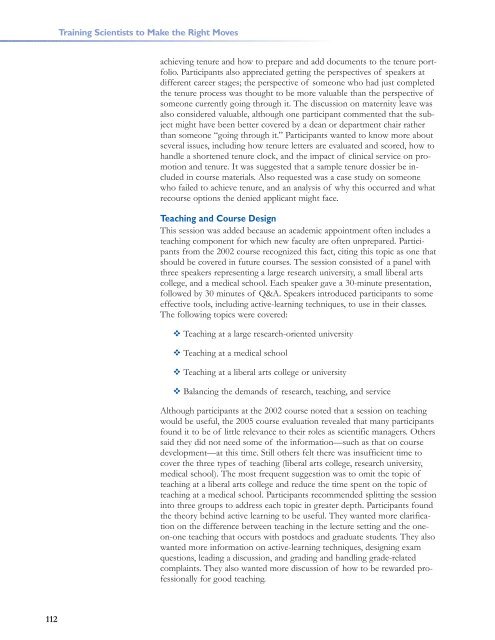Training Scientists to Make the Right Moves - Howard Hughes ...
Training Scientists to Make the Right Moves - Howard Hughes ...
Training Scientists to Make the Right Moves - Howard Hughes ...
Create successful ePaper yourself
Turn your PDF publications into a flip-book with our unique Google optimized e-Paper software.
<strong>Training</strong> <strong>Scientists</strong> <strong>to</strong> <strong>Make</strong> <strong>the</strong> <strong>Right</strong> <strong>Moves</strong><br />
achieving tenure and how <strong>to</strong> prepare and add documents <strong>to</strong> <strong>the</strong> tenure portfolio.<br />
Participants also appreciated getting <strong>the</strong> perspectives of speakers at<br />
different career stages; <strong>the</strong> perspective of someone who had just completed<br />
<strong>the</strong> tenure process was thought <strong>to</strong> be more valuable than <strong>the</strong> perspective of<br />
someone currently going through it. The discussion on maternity leave was<br />
also considered valuable, although one participant commented that <strong>the</strong> subject<br />
might have been better covered by a dean or department chair ra<strong>the</strong>r<br />
than someone “going through it.” Participants wanted <strong>to</strong> know more about<br />
several issues, including how tenure letters are evaluated and scored, how <strong>to</strong><br />
handle a shortened tenure clock, and <strong>the</strong> impact of clinical service on promotion<br />
and tenure. It was suggested that a sample tenure dossier be included<br />
in course materials. Also requested was a case study on someone<br />
who failed <strong>to</strong> achieve tenure, and an analysis of why this occurred and what<br />
recourse options <strong>the</strong> denied applicant might face.<br />
Teaching and Course Design<br />
This session was added because an academic appointment often includes a<br />
teaching component for which new faculty are often unprepared. Participants<br />
from <strong>the</strong> 2002 course recognized this fact, citing this <strong>to</strong>pic as one that<br />
should be covered in future courses. The session consisted of a panel with<br />
three speakers representing a large research university, a small liberal arts<br />
college, and a medical school. Each speaker gave a 30-minute presentation,<br />
followed by 30 minutes of Q&A. Speakers introduced participants <strong>to</strong> some<br />
effective <strong>to</strong>ols, including active-learning techniques, <strong>to</strong> use in <strong>the</strong>ir classes.<br />
The following <strong>to</strong>pics were covered:<br />
Teaching at a large research-oriented university<br />
Teaching at a medical school<br />
Teaching at a liberal arts college or university<br />
Balancing <strong>the</strong> demands of research, teaching, and service<br />
Although participants at <strong>the</strong> 2002 course noted that a session on teaching<br />
would be useful, <strong>the</strong> 2005 course evaluation revealed that many participants<br />
found it <strong>to</strong> be of little relevance <strong>to</strong> <strong>the</strong>ir roles as scientific managers. O<strong>the</strong>rs<br />
said <strong>the</strong>y did not need some of <strong>the</strong> information—such as that on course<br />
development—at this time. Still o<strong>the</strong>rs felt <strong>the</strong>re was insufficient time <strong>to</strong><br />
cover <strong>the</strong> three types of teaching (liberal arts college, research university,<br />
medical school). The most frequent suggestion was <strong>to</strong> omit <strong>the</strong> <strong>to</strong>pic of<br />
teaching at a liberal arts college and reduce <strong>the</strong> time spent on <strong>the</strong> <strong>to</strong>pic of<br />
teaching at a medical school. Participants recommended splitting <strong>the</strong> session<br />
in<strong>to</strong> three groups <strong>to</strong> address each <strong>to</strong>pic in greater depth. Participants found<br />
<strong>the</strong> <strong>the</strong>ory behind active learning <strong>to</strong> be useful. They wanted more clarification<br />
on <strong>the</strong> difference between teaching in <strong>the</strong> lecture setting and <strong>the</strong> oneon-one<br />
teaching that occurs with postdocs and graduate students. They also<br />
wanted more information on active-learning techniques, designing exam<br />
questions, leading a discussion, and grading and handling grade-related<br />
complaints. They also wanted more discussion of how <strong>to</strong> be rewarded professionally<br />
for good teaching.<br />
112
















